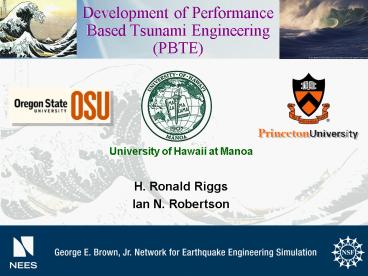Development of Performance Based Tsunami Engineering PBTE - PowerPoint PPT Presentation
1 / 35
Title:
Development of Performance Based Tsunami Engineering PBTE
Description:
Julie Young. Ocean engineering, hydromechanics. University of Hawaii, ORE. Geno Pawlak ... Julie Young. Ocean engineering, hydromechanics. University of Hawaii, ... – PowerPoint PPT presentation
Number of Views:111
Avg rating:3.0/5.0
Title: Development of Performance Based Tsunami Engineering PBTE
1
Development of Performance Based Tsunami
Engineering(PBTE)
- University of Hawaii at Manoa
- H. Ronald Riggs
- Ian N. Robertson
2
Tsunami Research
Fluid-Structure Interaction Scour
Modeling Structural Loading Structural Response
Coastal Inundation
Performance Levels
3
Project Team
4
Project Team
5
Project Team
6
Project Team
7
Project Team
8
Project Team
9
Project Team
10
Project Team
11
Advisory Panel
12
Advisory Panel
13
Advisory Panel
14
OSU Wave Tank Facility
15
Technical Areas
- Tsunami bore formation, runup, and coastal
inundation - Sediment transport and scour
- Fluid forces on structures
- Structural response, analysis and design
16
Runup Experiments and Modeling
- Site-specific bathymetry
- Effect of fringing reefs
- Surface roughness
- Bore formation
- Energy dissipation
17
Run-up Experiments
- Tsunami wave basin will be modified to allow for
three individual flumes with different bottom
slopes (July - Dec 2007)
18
Run-up Experiments-Constant Slope
- Solitary waves with heights at 0.05m increments
up to 0.65m - Study bore formation and energy dissipation
- Resistance wave gauges and Acoustic Doppler
Velocimeters (ADVs) will capture flow velocity - Benchmark tests for bed roughness, fringing reef,
scour and structural loading
19
Run-up Experiments-Fringing Reef
- Fringing reef will be simulated by curtailing the
beach slopes at h2, water level, and h2. - Solitary waves with height at 0.05m increments up
to 0.65m
20
Run-up Experiments
- Laser altimeter will track free surface when air
entrainment distorts resistance gauges and ADV
readings. - Particle Imaging Velocimetry (PIV) will monitor
transition to white water. - High speed camera will track markers on still
water and dry bed.
21
Sediment Transport and Scour
- Develop and validate sediment transport
mechanisms - Pump up of sediments due to large-scale vortices
created by bore collapse. - Entrainment of local sediment by instantaneous
bed shear stress. - Enhanced transport due to soil instability
(momentary static liquefaction caused by high
pore pressure during drawdown)
22
Scour Experiments
- Preliminary scour tests in Large Wave Flume (Fall
2006) - Utilize existing sand bed from beach erosion
experiment
- Velocity measurements using ADVs and PIV
- Sediment concentration using Fiber Optic
Backscatter (FOBS) - Pore pressures sensors to monitor soil instability
23
Sediment Transport Experiments
- Repeat 110 and 115 bottom slope tests with
moveable bed - Well-graded sand bed (0.2mm median grain size)
24
Scour Experiments
- Include plexiglass cylinder to simulate pile.
25
Fluid Forces on Structures
- Horizontal hydrodynamic loads
- Vertical hydrodynamic loads
- Debris impact loads
- Debris damming loads
26
Fluid-Structure Experiments
laser altimeter
high speed camera
piston
absorber
Simple Structure
- Utilize fringing reef setup to produce bore.
- Monitor loading on structural elements and simple
structural systems
27
Fluid-Structure Experiments
laser altimeter
high speed camera
piston
absorber
Shipping Container
- Utilize fringing reef setup to produce bore.
- Monitor loading on structural elements and simple
structural systems - Monitor debris damming effects
28
Fluid-Structure Simulation
- Use Reynolds Averaged Navier Stokes, RANS fluid
models with the experimental data to improve
fluid-structure interaction modeling - Combination of ABAQUS FLUENT
- Possible use of COMSOL (FEMLAB)
29
Structural Response and Design
- Structural response to hydraulic and impact loads
- Progressive collapse prevention
- Prescriptive design
- Methodology for site-specific PBTE
30
Performance Levels
31
Outreach
- Princeton REU program (summer 06)
- Review of existing design guidelines to protect
coastal structures against erosion and scour
damage. - Assist with design and setup of scour
experiments. - Oregon State University
- Web telecast of all experiments performed in the
TWB. - Selected experiments will be incorporated into an
educational webcast for K-12 audience. - University of Hawaii
- Summer 2006 two High School interns working on
preliminary FLUENT modeling - Enhancement of tsunami display at Bishop Museum
32
Education and Outreach
- Bishop Museum - Honolulu
33
(No Transcript)
34
Thank-you!
35
(No Transcript)































